tow Peugeot Partner Tepee 2015 Owner's Manual
[x] Cancel search | Manufacturer: PEUGEOT, Model Year: 2015, Model line: Partner Tepee, Model: Peugeot Partner Tepee 2015Pages: 276, PDF Size: 12.76 MB
Page 5 of 276
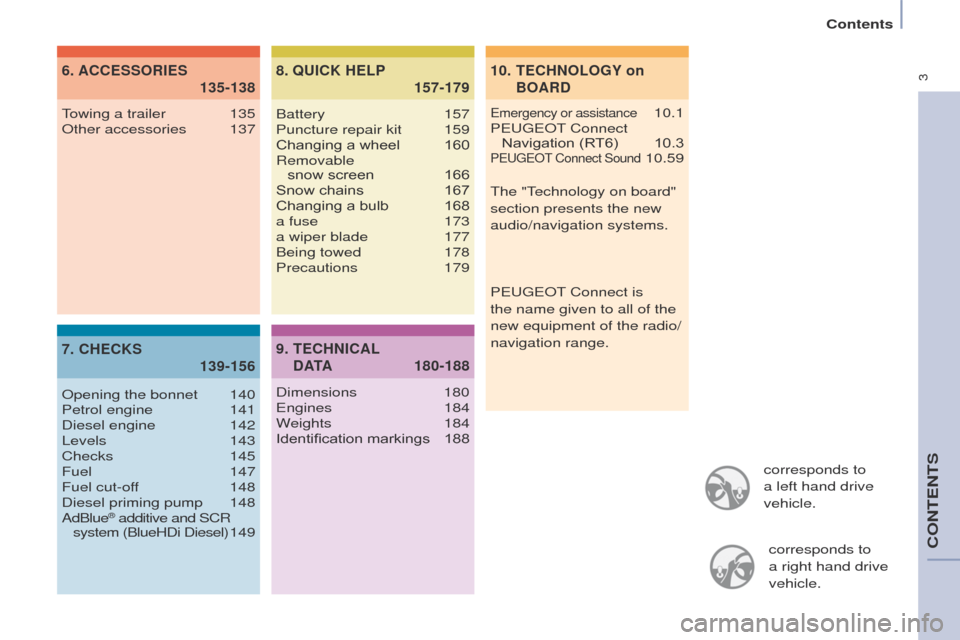
3
Partner_2_VP_en_Chap00a_Sommaire_ed02-2014
corresponds to
a left hand drive
vehicle.corresponds to
a
right hand drive
vehicle.
TECHNOLOGY on
BOARD
10.
ACCESSORIES
6.
135-138
CHECKS
7.
139-156 QUICK HELP
8.
157-179
emergency or assistance 10.1
Peuge
O
t Connect
Navigation (RT6)
10.3PeugeOt Connect Sound 10.59
towing a trailer
135
Other accessories
137
Opening the bonnet
140
Petrol engine
141
Diesel engine
142
Levels
143
Checks
145
Fuel
147
Fuel cut-off
148
Diesel priming pump
148
AdBlue® additive and SCR
system (BlueHDi Diesel) 1 49Battery
157
Puncture repair kit
159
Changing a wheel
160
Removable
snow screen
166
Snow chains
167
Changing a bulb
168
a fuse
173
a wiper blade
177
Being towed
178
Precautions
179
TECHNICAL
D ATA
9.
180-188
Dimensions 180e
ngines 184
Weights
184
Identification markings
188
t
he " t
echnology on board"
section presents the new
audio/navigation systems.
P
euge O t
Connect is
the name given to all of the
new equipment of the radio/
navigation range.
Contents
CONteNtS
Page 7 of 276
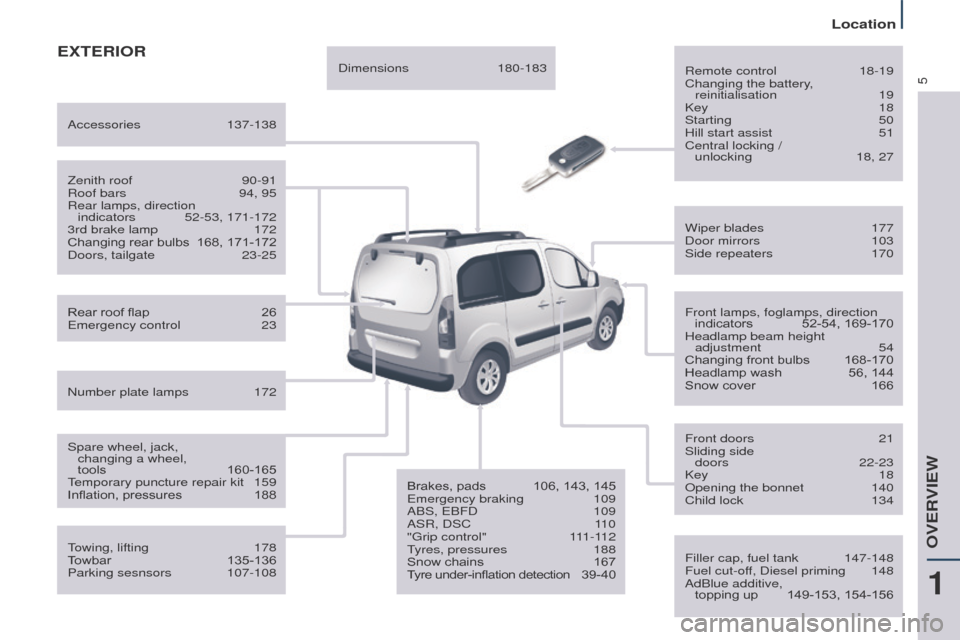
5
Partner_2_VP_en_Chap01_vue-ensemble_ed02-2014
EXTERIOR
Remote control 18-19
Changing the battery ,
reinitialisation
19
Key
18
Starting
50
Hill start assist
51
Central locking /
unlocking
18, 27
Filler cap, fuel tank
147-148
Fuel cut-of
f, Diesel priming
148
AdBlue additive,
topping up
149-153, 154-156
Wiper blades
177
Door mirrors
103
Side repeaters
170
Front lamps, foglamps, direction indicators
52-54, 169-170
Headlamp beam height adjustment
54
Changing front bulbs
168-170
Headlamp wash
56, 144
Snow cover
166
Front doors
21
Sliding side
doors
22-23
Key
18
Opening the bonnet
140
Child lock
134
towing, lifting
178
T
owbar
135-136
Parking sesnsors
107-108
Rear roof flap
26e
mergency control
23
Spare wheel, jack,
changing a wheel,
tools
160-165temporary puncture repair kit
159
Inflation, pressures
188
Zenith roof
90-91
Roof bars
94, 95
Rear lamps, direction
indicators
52-53, 171-172
3rd brake lamp
172
Changing rear bulbs
168, 171-172
Doors, tailgate
23-25
Accessories
137-138
Number plate lamps
172 Dimensions
180-183
Brakes, pads
106, 143, 145e
mergency braking
109
ABS,
e
BFD
109
ASR, DSC
1
10
"
g
rip control"
1
11-112
tyres, pressures
188
Snow chains
167
T
yre under-inflation detection
3
9-40
1
OVeRVIeW
Location
Page 8 of 276
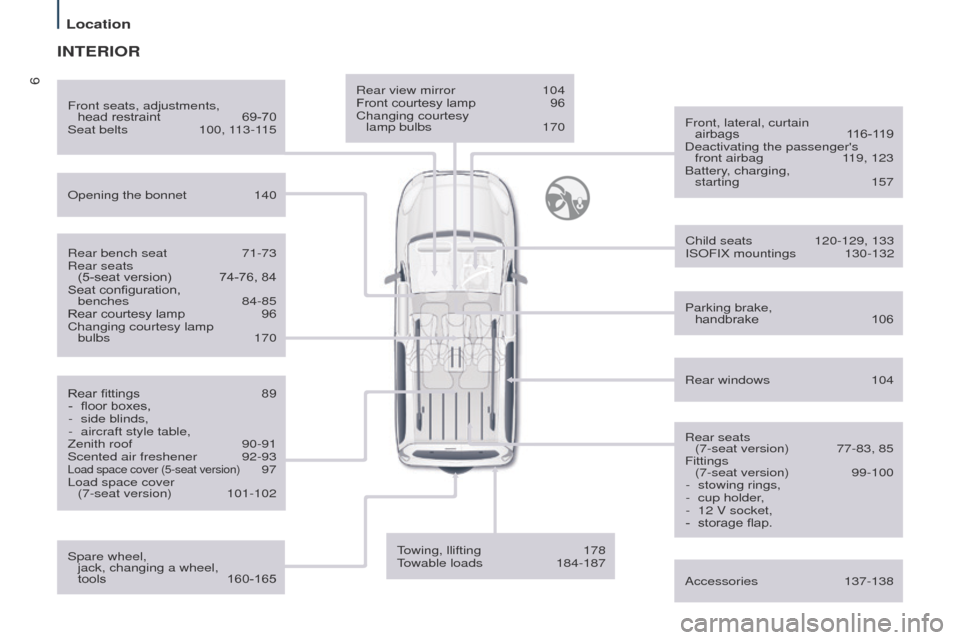
6
Partner_2_VP_en_Chap01_vue-ensemble_ed02-2014
Rear view mirror 104
Front courtesy lamp 96
Changing courtesy
lamp bulbs
170 Front, lateral, curtain
airbags
1
16-119
Deactivating the passenger's front airbag
1
19, 123
Battery, charging, starting
157
Opening the bonnet
140
Rear windows
104
Front seats, adjustments,
head restraint
69-70
Seat belts
100, 1
13-115
Accessories
137-138
INTERIOR
Rear bench seat 71-73
Rear seats
(5-seat version)
74-76, 84
Seat configuration,
benches
84-85
Rear courtesy lamp
96
Changing courtesy lamp
bulbs
170
Rear fittings
89
-
floor boxes,
-
side blinds,
-
aircraft style table,
Zenith roof
90-91
Scented air freshener
92-93Load space cover (5-seat version) 97
Load space cover
(7-seat version)
101-102 Child seats
120-129, 133
ISOFIX mountings
130-132
Parking brake,
handbrake
106
Rear seats
(7-seat version)
77-83, 85
Fittings
(7-seat version) 99-100
-
stowing rings,
-
cup holder
,
-
12 V socket,
-
storage flap.
towing, llifting
178towable loads
184-187
Spare wheel,
jack, changing a wheel,
tools
160-165
Location
Page 9 of 276
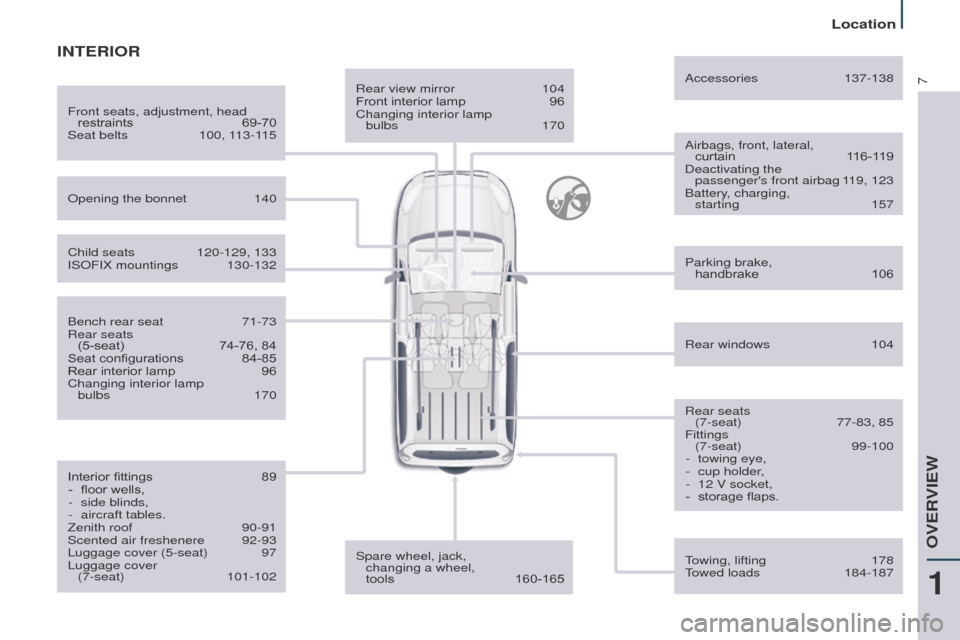
7
Partner_2_VP_en_Chap01_vue-ensemble_ed02-2014
Rear view mirror 104
Front interior lamp 96
Changing interior lamp
bulbs
170 Airbags, front, lateral,
curtain
1
16-119
Deactivating the passenger's front airbag
1
19, 123
Battery, charging, starting
157
Opening the bonnet
140
Rear windows
104
Front seats, adjustment, head
restraints
69-70
Seat belts
100, 1
13-115 Accessories
137-138
INTERIOR
Bench rear seat 71-73
Rear seats
(5-seat)
74-76, 84
Seat configurations
84-85
Rear interior lamp
96
Changing interior lamp
bulbs
170
Interior fittings
89
-
floor wells,
-
side blinds,
-
aircraft tables.
Zenith roof
90-91
Scented air freshenere
92-93
Luggage cover (5-seat)
97
Luggage cover
(7-seat)
101-102
Child seats
120-129, 133
ISOFIX mountings
130-132
Parking brake,
handbrake
106
Rear seats
(7-seat)
77-83, 85
Fittings
(7-seat)
99-100
-
towing eye,
-
cup holder
,
-
12 V socket,
-
storage flaps.
towing, lifting
178towed loads
184-187
Spare wheel, jack,
changing a wheel,
tools
160-165
1
OVeRVIeW
Location
Page 18 of 276

16eco-driving is a range of everyday practices that allow the motorist to o\
ptimise their fuel consumption and CO2
emissions.
Eco-driving
Optimise the use of your gearbox
With a manual gearbox, move off gently and change up
without waiting. During acceleration change up early.
With an automatic or electronic gearbox, give preference
to automatic mode and avoid pressing the accelerator
pedal heavily or suddenly.
t
he gear shift indicator invites you engage the most
suitable gear: as soon as the indication is displayed in the
instrument panel, follow it straight away.
For vehicles fitted with an electronic or automatic gearbox,
this indicator appears only in manual mode.
Drive smoothly
Maintain a safe distance between vehicles, use engine
braking rather than the brake pedal, and press the
accelerator progressively.
t
hese practices contribute
towards a reduction in fuel consumption and CO
2
emissions and also helps reduce the background traffic
noise.
If your vehicle has cruise control, make use of the system
at speeds above 25 mph (40 km/h) when the traffic is
flowing well.
Control the use of your electrical equipment
Before moving off, if the passenger compartment is too
warm, ventilate it by opening the windows and air vents
before using the air conditioning.
Above 30 mph (50 km/h), close the windows and leave the
air vents open.
Remember to make use of equipment that can help keep
the temperature in the passenger compartment down
(sunroof and window blinds...).
Switch off the air conditioning, unless it has automatic
regulation, as soon as the desired temperature is attained.
Switch off the demisting and defrosting controls, if not
automatic.
Switch off the heated seat as soon as possible.
Switch off the headlamps and front foglamps when the
level of light does not require their use.
Avoid running the engine before moving off, particularly in
winter; your vehicle will warm up much faster while driving.
As a passenger, if you avoid connecting your multimedia
devices (film, music, video game...), you will contribute
towards limiting the consumption of electrical energy, and
so of fuel.
Disconnect your portable devices before leaving the
vehicle.
Motoring & environment
Page 24 of 276

22
Partner_2_VP_en_Chap03_Pret-a-partir_ed02-2014
SLIDING SIDE DOORS
From the outside
Pull the handle towards you then
towards the rear and open the side
door guiding the rearward sliding to
beyond the point of resistance to hold
it open.
A mechanical system prevents opening
of the left-hand side door when the fuel
filler flap is open.
From the inside
unlock the side door using this handle
and open it, guiding the rearward
sliding to the point of resistance. Pass
this point to hold the door open.
Close the side door using the handle
to start the sliding and pass the point
of resistance.
t
hen, use the shaped
recess at the top of the door pillar to
guide the door until it locks.
Do not use the grab handle to slide the
door.
Good practice
take care not to block the guide space
on the floor to allow the door to slide
correctly
.
If your vehicle is parked on a slope,
guide the sliding of the side door. In
fact, the door could open or close more
rapidly due to the slope of the ground
and could cause injury.
For safety and operation reasons, do
not drive with the sliding side doors
open.
Access
Page 26 of 276
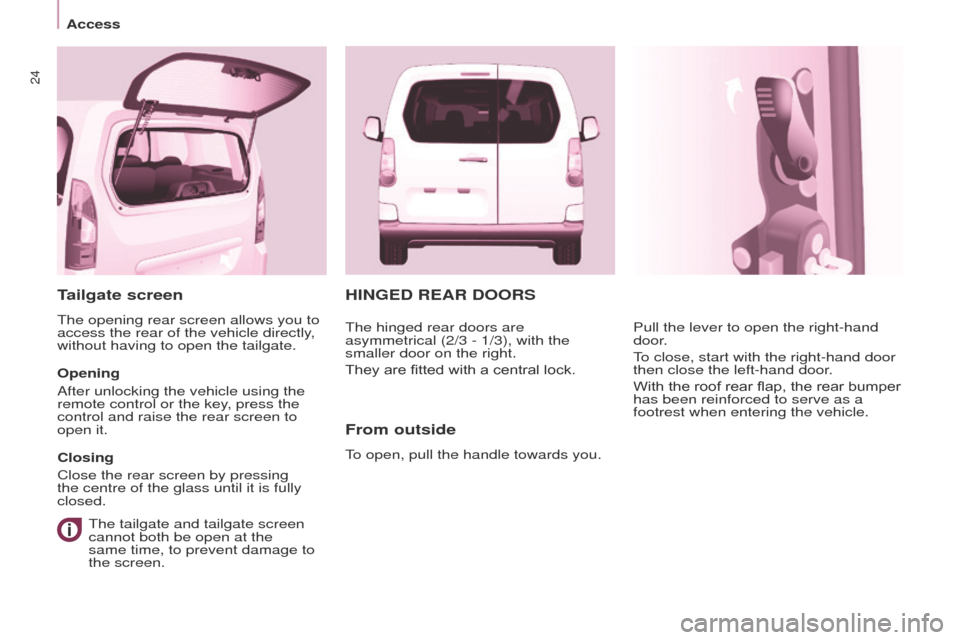
24
Partner_2_VP_en_Chap03_Pret-a-partir_ed02-2014
HINGED REAR DOORS
From outside
to open, pull the handle towards you.Pull the lever to open the right-hand
door
.
to close, start with the right-hand door
then close the left-hand door
.
With the roof rear flap, the rear bumper
has been reinforced to serve as a
footrest when entering the vehicle.
t
he hinged rear doors are
asymmetrical (2/3 - 1/3), with the
smaller door on the right.
They are fitted with a central lock.
Tailgate screen
the opening rear screen allows you to
access the rear of the vehicle directly ,
without having to open the tailgate.
Opening
After unlocking the vehicle using the
remote control or the key, press the
control and raise the rear screen to
open it.
Closing
Close the rear screen by pressing
the centre of the glass until it is fully
closed.
t he tailgate and tailgate screen
cannot both be open at the
same time, to prevent damage to
the
screen.
Access
Page 27 of 276
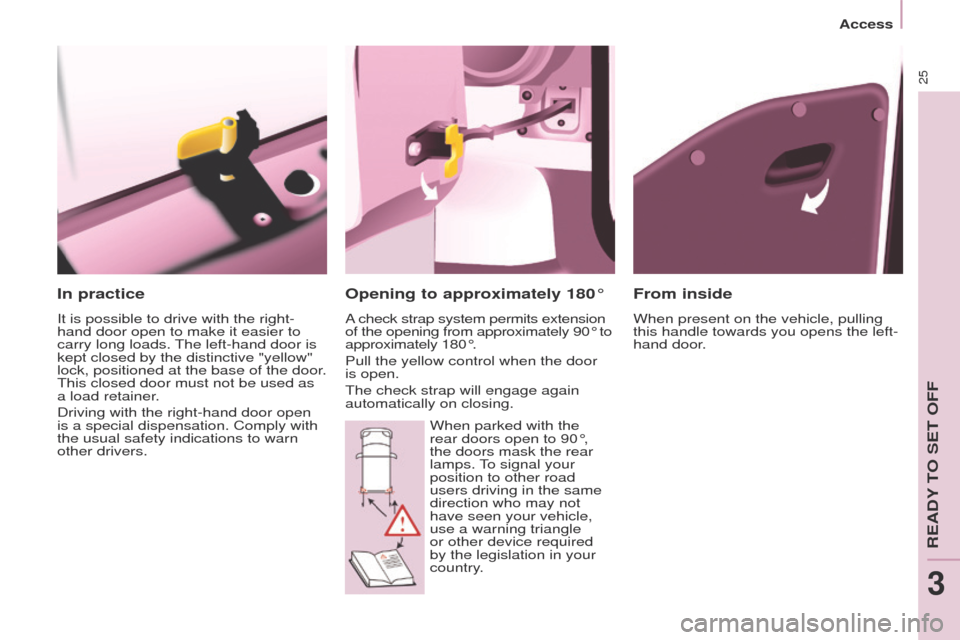
25
Partner_2_VP_en_Chap03_Pret-a-partir_ed02-2014
In practice
It is possible to drive with the right-
hand door open to make it easier to
carry long loads.
t
he left-hand door is
kept closed by the distinctive "yellow"
lock, positioned at the base of the door.
t
his closed door must not be used as
a load retainer.
Driving with the right-hand door open
is a special dispensation. Comply with
the usual safety indications to warn
other drivers.
From inside
When present on the vehicle, pulling
this handle towards you opens the left-
hand door.
Opening to approximately 180°
A check strap system permits extension
of the opening from approximately 90° to
approximately 180°.
Pull the yellow control when the door
is open.
t
he check strap will engage again
automatically on closing.
When parked with the
rear doors open to 90°,
the doors mask the rear
lamps.
to signal your
position to other road
users driving in the same
direction who may not
have seen your vehicle,
use a warning triangle
or other device required
by the legislation in your
country
.
Access
ReADY tO Set OFF
3
Page 38 of 276
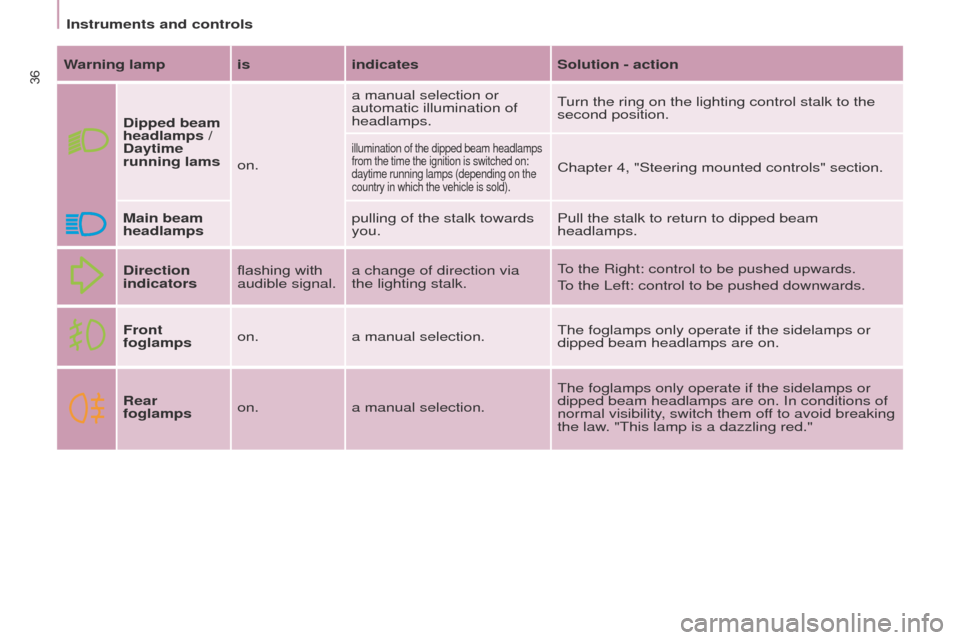
36
Partner_2_VP_en_Chap03_Pret-a-partir_ed02-2014
Warning lamp isindicatesSolution - action
Dipped beam
headlamps
/
Daytime
running lams on.a manual selection or
automatic illumination of
headlamps.
turn the ring on the lighting control stalk to the
second position.
illumination of the dipped beam headlamps
from the time the ignition is switched on:
daytime running lamps (depending on the
country in which the vehicle is sold).
Chapter 4, "Steering mounted controls" section.
Main beam
headlamps pulling of the stalk towards
you.Pull the stalk to return to dipped beam
headlamps.
Direction
indicators flashing with
audible signal.a change of direction via
the lighting stalk.
to the Right: control to be pushed upwards.
to the Left: control to be pushed downwards.
Front
foglamps on.
a manual selection.
t
he foglamps only operate if the sidelamps or
dipped beam headlamps are on.
Rear
foglamps on.
a manual selection.
t
he foglamps only operate if the sidelamps or
dipped beam headlamps are on. In conditions of
normal visibility, switch them off to avoid breaking
the law. "
t his lamp is a dazzling red."
Instruments and controls
Page 54 of 276
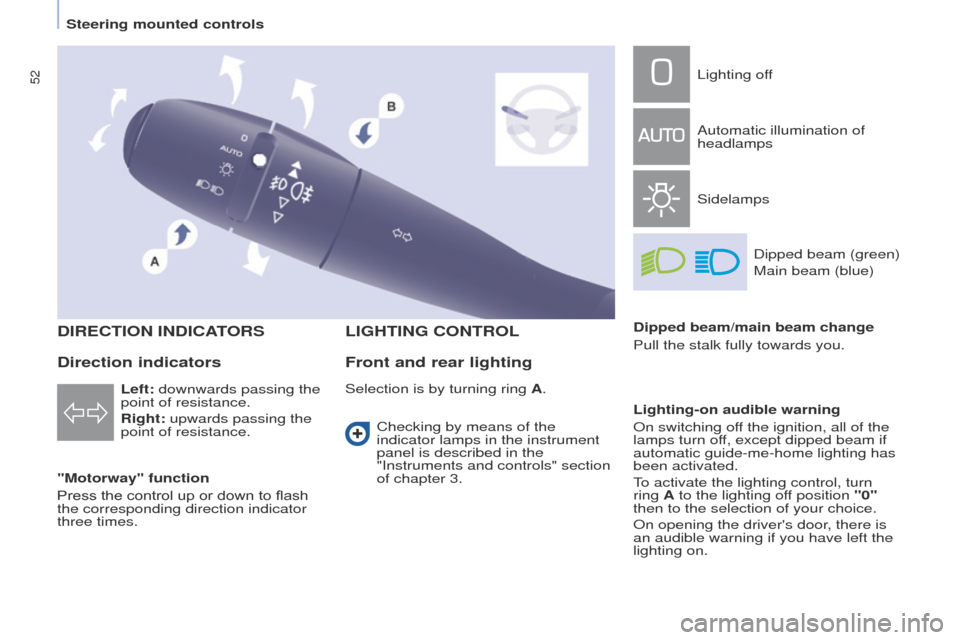
52
Partner_2_VP_en_Chap04_ergonomie_ed02-2014
DIRECTION INDICATORS
"Motorway" function
Press the control up or down to flash
the corresponding direction indicator
three times.
LIGHTING CONTROL
Left: downwards passing the
point of resistance.
Right: upwards passing the
point of resistance.
Front and rear lighting
Lighting off
Automatic illumination of
headlamps
SidelampsDipped beam (green)
Main beam (blue)
Dipped beam/main beam change
Pull the stalk fully towards you.
Lighting-on audible warning
On switching off the ignition, all of the
lamps turn off, except dipped beam if
automatic guide-me-home lighting has
been activated.
to activate the lighting control, turn
ring A to the lighting off position "0"
then to the selection of your choice.
On opening the driver's door, there is
an audible warning if you have left the
lighting on.
Checking by means of the
indicator lamps in the instrument
panel is described in the
"Instruments and controls" section
of chapter 3.
Direction indicators
Selection is by turning ring A.
Steering mounted controls